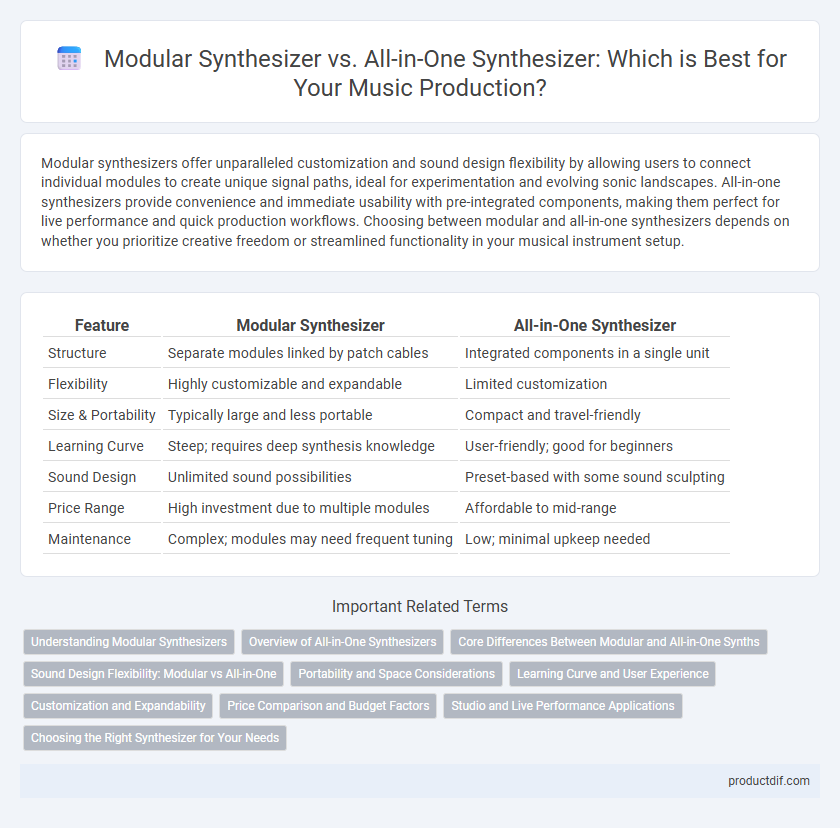Modular synthesizers offer unparalleled customization and sound design flexibility by allowing users to connect individual modules to create unique signal paths, ideal for experimentation and evolving sonic landscapes. All-in-one synthesizers provide convenience and immediate usability with pre-integrated components, making them perfect for live performance and quick production workflows. Choosing between modular and all-in-one synthesizers depends on whether you prioritize creative freedom or streamlined functionality in your musical instrument setup.
Table of Comparison
| Feature | Modular Synthesizer | All-in-One Synthesizer |
|---|---|---|
| Structure | Separate modules linked by patch cables | Integrated components in a single unit |
| Flexibility | Highly customizable and expandable | Limited customization |
| Size & Portability | Typically large and less portable | Compact and travel-friendly |
| Learning Curve | Steep; requires deep synthesis knowledge | User-friendly; good for beginners |
| Sound Design | Unlimited sound possibilities | Preset-based with some sound sculpting |
| Price Range | High investment due to multiple modules | Affordable to mid-range |
| Maintenance | Complex; modules may need frequent tuning | Low; minimal upkeep needed |
Understanding Modular Synthesizers
Modular synthesizers consist of individual components such as oscillators, filters, and amplifiers that users connect with patch cables to create custom signal paths and unique sounds. This flexibility allows for infinite sound design possibilities, contrasting with all-in-one synthesizers that offer pre-wired, integrated circuits tailored for immediate playability but limited modulation options. Understanding modular synthesizers involves mastering signal flow and voltage control concepts, enabling musicians to build personalized instruments that evolve with their creative needs.
Overview of All-in-One Synthesizers
All-in-one synthesizers integrate oscillators, filters, envelopes, and modulation sources into a single, compact unit designed for immediate playability and streamlined workflow. These synthesizers often feature preset memory, built-in effects, and user-friendly interfaces that cater to both beginners and professionals seeking portable, versatile sound design tools. Their cohesive architecture eliminates complex patching, enabling swift sound creation and live performance adaptability without the need for additional modules.
Core Differences Between Modular and All-in-One Synths
Modular synthesizers consist of separate, interchangeable modules such as oscillators, filters, and sequencers, enabling customized sound design and extensive signal routing flexibility. All-in-one synthesizers integrate all components into a single unit, offering convenience, preset memory, and streamlined workflow for faster music production. The core difference lies in modular synths' adaptability and complexity, contrasted with the all-in-one synths' user-friendly, compact design tailored for immediate use.
Sound Design Flexibility: Modular vs All-in-One
Modular synthesizers offer unparalleled sound design flexibility by allowing users to customize and reconfigure individual components, such as oscillators, filters, and envelopes, to create unique and complex sounds. All-in-one synthesizers provide convenience with pre-integrated modules and presets but limit the scope for deep customization and experimentation. Enthusiasts seeking intricate sound sculpting typically prefer modular setups, while those prioritizing ease of use may opt for all-in-one models.
Portability and Space Considerations
Modular synthesizers offer unparalleled customization but require significant space and careful organization of individual modules, making them less portable and ideal for stationary studio setups. All-in-one synthesizers combine multiple functions into a single compact unit, enhancing portability and convenience for musicians with limited space or those frequently performing live. Evaluating workspace constraints and mobility needs is crucial in choosing between the expansive modular system and the integrated all-in-one synthesizer.
Learning Curve and User Experience
Modular synthesizers present a steep learning curve due to their complex patching and signal routing, requiring users to understand individual modules and signal flow intricacies. All-in-one synthesizers offer a more intuitive user experience by integrating sound generation, modulation, and effects within a single interface, enabling quicker sound design and performance readiness. Beginners often find all-in-one synthesizers more accessible, while modular systems appeal to advanced users seeking deep customization and experimental sound creation.
Customization and Expandability
Modular synthesizers offer unparalleled customization through individual modules that can be combined and reconfigured to create unique sounds tailored to specific needs. All-in-one synthesizers provide a fixed architecture with preset features, limiting expandability but ensuring ease of use. Modular systems excel in expandability, allowing users to continuously add new modules for complex sound design, unlike the more limited growth potential of all-in-one synths.
Price Comparison and Budget Factors
Modular synthesizers generally involve higher upfront costs due to the need to purchase individual modules such as oscillators, filters, and envelopes separately, which can quickly add up beyond $1,000 for a basic setup. In contrast, all-in-one synthesizers provide an integrated system with presets and built-in effects at a lower price point, often between $300 and $1,000, making them more accessible for budget-conscious musicians. Budget factors should consider not only initial expenses but ongoing costs for expansion and customization in modular systems versus the fixed capabilities of all-in-one units.
Studio and Live Performance Applications
Modular synthesizers provide unparalleled customization and hands-on control, making them ideal for studio environments where sound design precision and experimentation are paramount. All-in-one synthesizers offer a compact, integrated solution with presets and streamlined workflows, favored in live performances for their portability and reliability. Both instruments cater to different professional needs, with modular setups excelling in sonic flexibility and all-in-one units ensuring ease of use during high-pressure shows.
Choosing the Right Synthesizer for Your Needs
Modular synthesizers offer unparalleled customization and sound design flexibility, allowing musicians to tailor every aspect of their instrument through interchangeable modules. All-in-one synthesizers provide a more streamlined, user-friendly experience with integrated features and presets, ideal for performers seeking efficiency and ease of use. Evaluating your workflow, technical expertise, and creative goals will help determine whether the expansive possibilities of modular synthesis or the convenience of all-in-one systems best suits your musical needs.
Modular Synthesizer vs All-in-One Synthesizer Infographic

 productdif.com
productdif.com